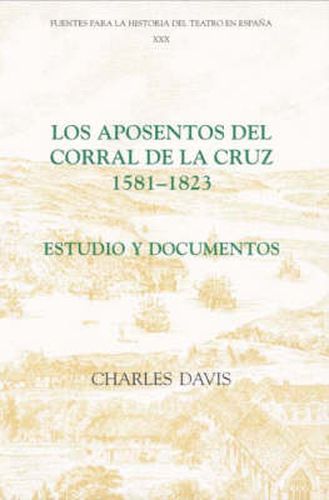Readings Newsletter
Become a Readings Member to make your shopping experience even easier.
Sign in or sign up for free!
You’re not far away from qualifying for FREE standard shipping within Australia
You’ve qualified for FREE standard shipping within Australia
The cart is loading…






A detailed study of the private boxes of Madrid’s first permanent playhouse The Corral de la Cruz (1579-1736) is the less well known of Madrid’s Golden Age playhouses. This latest volume in Tamesis’s Fuentes series is a detailed study of one of its most distinctive features: the boxes, or aposentos, from which the privileged and powerful, including Philip IV, witnessed the premieres of so many plays by Lope de Vega, Calderon and others. These boxes were rooms overlooking the yard, but were situated in private houses outside the walls of the playhouse, with independent access. Their structure and history are traced here through a substantial corpus of new documents containing information on the location, structure, dimensions, owners, lessees and users of the boxes and the houses, as well as the vexed question of payment for viewing rights. This provides an indispensable basis for the reconstruction of the first permanent theatre in the Spanish capital, in both its architectural and socioeconomic aspects. Charles Davis is a Ramon y Cajal Research Fellow at the University of Valencia and Honorary Research Fellow of Queen Mary, University of London Estudio pormenorizado de los aposentos del primer teatro permanente de Madrid El Corral de la Cruz (1579-1736) es el menos conocido de los dos corrales de comedias madrilenos. Este ultimo tomo de las Fuentes de Tamesis es un estudio pormenorizado de uno de sus elementos mas caracteristicos: los aposentos, o palcos, desde donde los espectadores mas privilegiados, entre ellos el propio Felipe IV, presenciaban los estrenos de tantas obras de Lope de Vega, Calderon y otros. Eran habitaciones que daban al patio, pero estaban situadas en casas particulares fuera de las medianerias del teatro, con entradas independientes. Se traza aqui su historia y estructura a traves de un nutrido corpus documental que ofrece nuevos datos sobre la ubicacion, estructura, medidas, propietarios, inquilinos y usuarios de los aposentos y las casas, ademas de la problematica de los pagos por vistas. Todo ello constituye un punto de partida imprescindible para reconstruir el primer teatro permanente de Madrid, en sus aspectos arquitectonicos y socioeconomicos. Charles Davis es investigador por el programa Ramon y Cajal en la Universitat de Valencia y Honorary Research Fellow de Queen Mary, Universidad de Londres
$9.00 standard shipping within Australia
FREE standard shipping within Australia for orders over $100.00
Express & International shipping calculated at checkout
A detailed study of the private boxes of Madrid’s first permanent playhouse The Corral de la Cruz (1579-1736) is the less well known of Madrid’s Golden Age playhouses. This latest volume in Tamesis’s Fuentes series is a detailed study of one of its most distinctive features: the boxes, or aposentos, from which the privileged and powerful, including Philip IV, witnessed the premieres of so many plays by Lope de Vega, Calderon and others. These boxes were rooms overlooking the yard, but were situated in private houses outside the walls of the playhouse, with independent access. Their structure and history are traced here through a substantial corpus of new documents containing information on the location, structure, dimensions, owners, lessees and users of the boxes and the houses, as well as the vexed question of payment for viewing rights. This provides an indispensable basis for the reconstruction of the first permanent theatre in the Spanish capital, in both its architectural and socioeconomic aspects. Charles Davis is a Ramon y Cajal Research Fellow at the University of Valencia and Honorary Research Fellow of Queen Mary, University of London Estudio pormenorizado de los aposentos del primer teatro permanente de Madrid El Corral de la Cruz (1579-1736) es el menos conocido de los dos corrales de comedias madrilenos. Este ultimo tomo de las Fuentes de Tamesis es un estudio pormenorizado de uno de sus elementos mas caracteristicos: los aposentos, o palcos, desde donde los espectadores mas privilegiados, entre ellos el propio Felipe IV, presenciaban los estrenos de tantas obras de Lope de Vega, Calderon y otros. Eran habitaciones que daban al patio, pero estaban situadas en casas particulares fuera de las medianerias del teatro, con entradas independientes. Se traza aqui su historia y estructura a traves de un nutrido corpus documental que ofrece nuevos datos sobre la ubicacion, estructura, medidas, propietarios, inquilinos y usuarios de los aposentos y las casas, ademas de la problematica de los pagos por vistas. Todo ello constituye un punto de partida imprescindible para reconstruir el primer teatro permanente de Madrid, en sus aspectos arquitectonicos y socioeconomicos. Charles Davis es investigador por el programa Ramon y Cajal en la Universitat de Valencia y Honorary Research Fellow de Queen Mary, Universidad de Londres